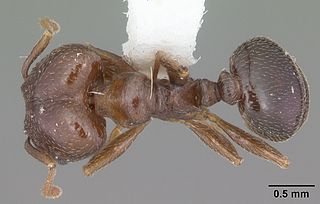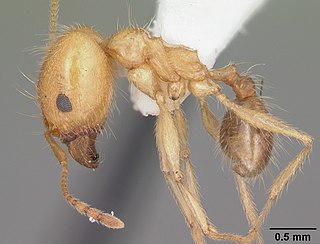
Pheidole is a genus of ants that belongs to the ant subfamily Myrmicinae. The genus is widespread and ecologically dominant. It probably includes more than 1000 species. The genus first evolved in the Americas, eventually spreading across the globe.
Barry Bolton is an English myrmecologist, an expert on the classification, systematics, and taxonomy of ants, who long worked at the Natural History Museum, London. He is known especially for monographs on African and Asian ants, and for encyclopaedic global works, including the Identification Guide to Ant Genera (1994), A New General Catalogue of Ants of the World, Synopsis and Classification of Formicidae (2003), and Bolton's Catalogue of Ants of the World: 1758-2005 (2007). Now retired, Bolton is a Fellow of the Royal Entomological Society and Myrmecologist, Biodiversity Division, Department of Entomology, Natural History Museum, London.

Pheidole inquilina is a species of ant in the genus Pheidole. It is endemic to the United States.

Pheidole megacephala is a species of ant in the subfamily Myrmicinae. It is commonly known as the big-headed ant in the US and the coastal brown ant in Australia. It is a very successful invasive species and is considered a danger to native ants in Australia and other places. It is regarded as one of the world's worst invasive ant species.
Pheidole sulcaticeps is a species of ant in the subfamily Myrmicinae.

Pheidole metallescens is an ant, a species of higher myrmicine in the family Formicidae.

Orasema occidentalis is a species of chalcid wasp in the family Eucharitidae. The species is a parasite of Pheidole desertorum.

Pheidole vistana is a species of ant and a higher myrmicine in the family Formicidae.

Pheidole moerens is an ant, a species of higher myrmicine in the family Formicidae.

Pheidole rhea is a species of ant and a higher myrmicine in the family Formicidae. It is common in grassy slopes and hills at the bases of mountains.

Pheidole xerophila is a species of ant and a higher myrmicine in the family Formicidae.

Pheidole californica is an ant, a species of higher myrmicine in the family Formicidae.

Pheidole obtusospinosa is a species of ant and a higher myrmicine in the family Formicidae.

Pheidole pilifera is a species of ant and a higher myrmicine in the family Formicidae.

Pheidole hyatti is a species of big-headed ant native to the southwest United States, Mexico, and Guatemala, invasive in Hawaii, and possibly present in Panama, Bolivia, and Argentina.

Pheidole crassicornis is an ant, a species of higher myrmicine in the family Formicidae.

Pheidole morrisii is a species of ant and a higher myrmicine in the family Formicidae.

Pheidole dentigula is an ant, a species of higher myrmicine in the family Formicidae.

Pheidole cerebrosior is a species of higher myrmicine in the family Formicidae.

















